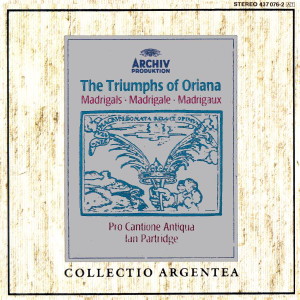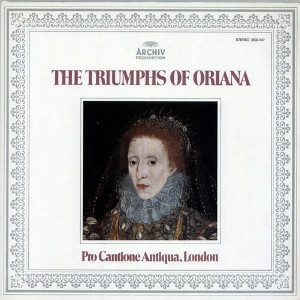 |
|
1 CD -
437 076-2 - (c) 1986
|
 |
| 1 LP -
2533 347 - (p) 1977 |
|
THE
TRIUMPHS OF ORIANA - Madrigals
(1601)
|
|
|
|
|
|
| - Hence stars!
too dim of light (Michael
East, c.1580-1648) |
2' 15" |
|
| 1. With angel's
face and brightness (Daniel
Norcombe, 1576 - before 1626) |
2' 27" |
|
| 2. Lightly she
whipped o'er the dales (John
Mundy, c.1529 - ?1591) |
3' 27" |
|
| 3. Long live
fair Oriana (Hark, did you ever
hear?) (Ellis Gibbons,
1573-?1603) |
2' 42" |
|
| 4.
All creatures now
are merry-minded (John Bennet, c.1575-80;
fl.1599-1644) |
2' 05" |
|
| 5. Fair
Oriana, beauty's queen
(Joihn Hilton, ? - c.1608) |
2' 13" |
|
| 6. The nymphs
and shepherds danced (George
Marson, c.1573-1632) |
2' 38" |
|
| 7. Calm was te
air and clear the sky
(Richard Carlton, c.1558-?1638) |
2' 49" |
|
| 8. Thus Bonny-boots the
birthday celebrated (John Holmes, ?-1629) |
2' 32" |
|
| 9. Sing,
shepherds all, and in your
roundelays (Richard
Nicholson, fl.1595; d.1639) |
3' 12" |
|
| 10. The fauns and satyrs
tripping (Thomas Thomkins,
1572-1656) |
4' 45" |
|
| 11. Come.
gentle swains and shepherds'
dainty daughters (Michael
Cavendish, c.1565-1628) |
1' 37" |
|
| 12.
With wreaths of
rose and laurel (William Cobbold,
1560-1639) |
2' 14" |
|
| 13. Arise, awake, awake (Thomas Morley,
1557/8-1602) |
1' 52" |
|
| 14. Fair nymphs I heard one
telling (John Farmer, c.1570;
fl.1591/1601) |
2' 06" |
|
| 15. The lady Oriana (John Wilbye, 1574-1638) |
2' 13" |
|
| 16. Hark! did ye ever hear
so sweet a
singing? (Thomas
Hunt, fl. c.1600) |
3' 06" |
|
| 17. As Vesta was from
Latmos hill descending (Thomas Weelkes,
1576-1623) |
3' 24" |
|
| 18. Fair Orian, in the morn (John Milton,
c.1563-1647) |
2' 00" |
|
| 19. Round about her
charret, with all-admiring
strains (Ellis Gibbons) |
2' 28" |
|
| 20. With angel's face and
brightness (George Kirbye, ?-1634) |
2' 05" |
|
| 21. Fair Oriana,
seeming to wink at folly
(Robert Jones, fl.1597-1615) |
2' 55"
|
|
| 22. Fair Cytherea presents
her doves; Minerva
sweetly singeth (John Lisley, ?) |
2' 01" |
|
| 23. Hard by a
crystal fountain (Thomas Morley) |
3' 31"
|
|
| 24. Come, blessed bird and
with thy sugared relish (Edward Johnson,
fl.1572-1601) |
3' 06" |
|
|
|
|
| PRO CANTIONE ANTIQUA /
Ian Partridge, Direction |
|
| James
Bowman, Paul Esswood, James Griffett, Ian
Partridge, Brian Etheridge, David
Thomas |
|
| with |
|
Jennifer
Smith, Leonie
Mitchell
|
|
|
|
|
|
Luogo
e data di registrazione |
|
All
Saints' Church, Petersham
(Germania) - maggio 1976 |
|
|
Registrazione:
live / studio |
|
studio |
|
|
Producer /
Engineer |
|
Mark
Brown / Tony Faulkner |
|
|
Prima Edizione
LP |
|
Archiv
- 2533 347 - (1 lp) - durata 65'
43" - (p) 1977 - Analogico |
|
|
Edizione
"Collectio" CD |
|
Archiv
- 437 076-2 - (1 cd) - durata 65'
43" - (c) 1986 - ADD |
|
|
Note |
|
- |
|
|
|
|
THE
TRIUMPHS OF
ORIANA
The
British Princess Oriana was
the maiden beloved of the
hero in that favourite
romance of the 16th century,
Amadis de Gaule. What
better name, then, with
which to honour the Virgin
Queen of England, Elizabeth?
Its fitness had already been
suggested by her courtiers
when Nicholas Yonge, who
pioneered the printing of
madrigals in England with
his Musica Transalpina
(1588), published a second
anthology of the same title
(1597) which, like the
first, contained Italian
madrigals with English
words. The last item in the
1597 volume was a setting of
a madrigal by Giovanni
Croce, “Ove tra l’herbe e i
fiori”, and it was chosen to
round off the collection
because its new English text
celebrated Elizabeth as
Oriana:
For she the
shepherd’s life maintains
and yours.
Then sang
the shepherds and nymphs
of Diana:
Long live
fair Oriana.
This retrain
had an immediate appeal, and
was used by Michael
Cavendish for a madrigal
published in the next year.
But, more important, it
suggested to Thomas Morley,
who alluded to it in one of
his Canzonets (1597),
an altogether more ambitious
project. Croce’s madrigal
was from a collection of 29
works, by different poets
and composers, commissioned
by a rich Venetian to honour
his bride. This collection,
Il
trionfo di Dori (Venice,
1592; reprinted Antwerp,
1596), was the direct
inspiration for The
Triumphs of Oriana,
of which the penultimate
item is Morley’s own
adaptation and expansion of
Croce’s piece, utilizing the
Musica Transalpina
words. The
association seems
particularly appropriate,
for Morley had not merely
followed in the footsteps of
Yonge by popularizing the
Italian madrigal; he had
gone beyond this and
composed prolifically in the
Italian idiom, and the
popularity of his
publications had proved
decisive in creating the
English vogue for madrigal
composition. His works had
all the more influence
because he was a Gentleman
of the Chapel Royal,
organist of St. Paul’s
Cathedral, and widely
recognized as one of the
most distinguished pupils of
England’s greatest living
musician, William Byrd. The
debt to Byrd was
acknowledged when Morley
dedicated his Plaine and
Easie Introduction
to Practicall Musicke
(1597) to his former master,
whilst Morley’s own status
received important
recognition and reward when,
in 1598, he was granted by
the Qieen the right to
exercise that monopoly of
music printing which had
formerly belonged to Byrd.
So it was a musician
favoured by the Virgin Queen
who set out to honour
her in 26
madrigals - 26 being,
according to Ptolemy, the
number of stars in the
constellation of Virgo.
This plan was never fully
to materialize. Two of the
contributions arrived
late: Michael East’s
“Hence stars! too dim of
light” had to be left
unnumbered, with an
apologetic note by the
printer that he had placed
it “before the rest”
rather than omit it;
Thomas Bateson’s offering
was even longer delayed,
and finally
appeared in Bateson’s own
First Set of
English Mudrigals
(1604) with a note that it
“should have been printed
in the set of Orianas”.
There were other
difficulties in the
production of the book:
Kirbye’s contribution
proved to be on the same
text as Daniel Norcombe’s
“With angel’s face and
brightness”; Morley fitted
a new text to the music
(“Bright Phoebus greets”),
but in the second edition
of The Triumphs
he restored the
original words -
presumably at Kirbye’s
request, since the
madrigal is much more
satisfactory in this form
(it is performed with
these original Words on
this recording).
Nevertheless it is clear
that much thought and care
went into the project:
Cavendish, for instance,
entirely reworked the
“Oriana” madrigal which he
had published in his Ayres
of 1598, and it cannot
have been easy for Morley
(who died in 1602, and
seems to have been ill and
“compelled to keep at
home” from 1597) to End 23
musicians willing and able
to compose the madrigals.
Some, such as John
Milton, father of the
poet, were minor figures
who had not
appeared in print before.
Others, such as John
Wilbye and Morley’s
“dearest friend”, Thomas
Weelkes, were established
madrigal composers, with
substantial published
works to their credit, who
used the opportunity to
display their mastery, and
contributed works that
must rank amongst their
finest.
Morley published The
Triumphs in 1601; it
was reprinted in the same
year and seems to have
achieved considerable
popularity. Yet the aged
(breeds reign was coming
to an end in an atmosphere
far removed from that of
the Arcadian celebrations
that the madrigals evoke.
At the end of February
1601 her former favourite,
the Earl of Essex, had
been executed for his
attempt at rebellion.
Elizabeth feared new plots
and, according to one
witness, was visibly
wasted, ate little, and
kept a sword beside her
table. Morley alludes to
the recent troubles in his
dedication of “these few
discordant tunes” to
Charles Howard, Earl of
Nottingham and Lord of
Effingham - the man who
had defeated the Spanish
Armada, and who had
finally forced Essex to
surrender in his house
beside the Thames. These
circumstances have
encouraged scholars to
speculate about The
Triumphs, for there
are obvious problems. Who
was “Bonnyboots”, who
appears to be alive in
Holmes’ madrigal, but dead
in Johnson’s?
From other sources he is
known to have died by
1597; was Holmes’ madrigal
composed so early? Is
it possible that some of
the madrigals may
originally have formed
part of a rnasque or
pageant designed to
entertain the Queen?
But these questions must
remain unanswered: there
is certainly no direct
reference to any
entertainment, and the
satyrs, nymphs and
shepherds of the Orianas
need have no more
connection with actual
events than the fauni,
pastori and ninfe
of Il trionfo di
Dori.
Morley’s intention in
making the collection is
clear enough, and The
Triumphs remain a
constellation of madrigals
blazoning the honour of
his Queen.
Richard
Luckett
|
|